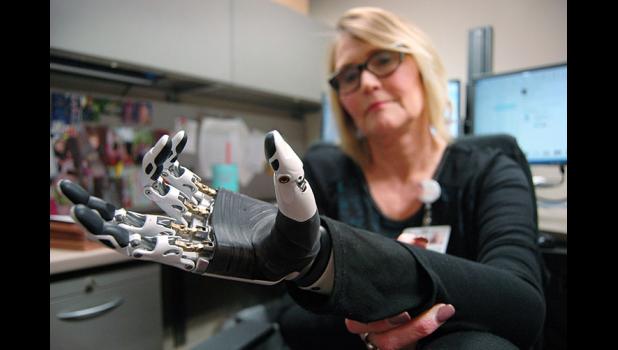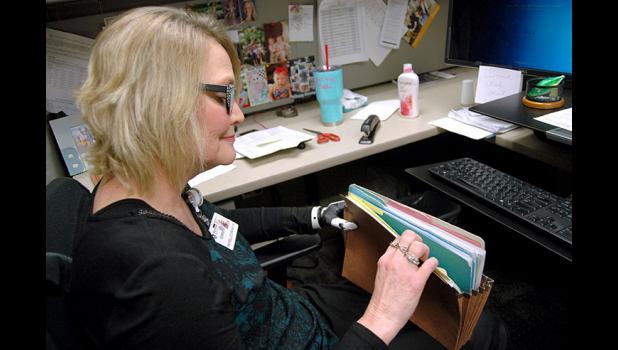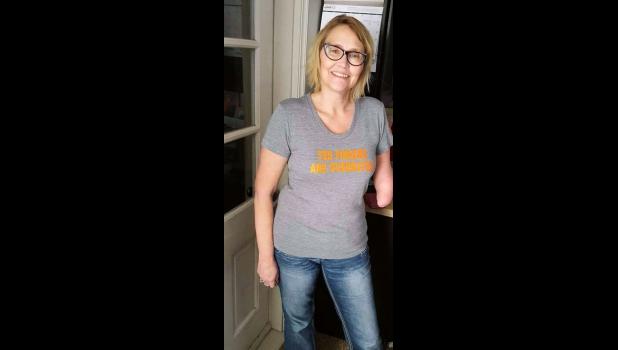Cyborg chic
By ANDREW MCGINN
a.mcginn@beeherald.com
A pepper grinder.
Of all the hurdles Debbie Roberts has overcome in the 53 years since being born without a left hand, she had no idea how much she apparently longed to be able to use a pepper grinder.
The former Debbie Wilson had no trouble learning to drive, raising kids or using a computer.
She even worked for two years at the truck stop in Webster City, inspiring the Des Moines Register to seek her out more than 30 years ago for a story about the waitress who did everything one handed.
Until two weeks ago, though, Roberts never could have cut it working at the Olive Garden.
Using a pepper grinder was simply a task too great.
Roberts found herself moved to tears this past fall when she saw a video on Facebook of former Miss Iowa Nicole Kelly — a woman also born without a left forearm — using her new robotic hand to twist a pepper grinder.
“I sat and cried,” Roberts said Friday.
The video — and the myoelectric prosthesis making Kelly’s body whole — was a revelation.
“She opened a beer, too,” Roberts said. “That was cool.”
A Greene County native who hasn’t worn a prosthetic limb for more than 30 years, deeming them too heavy and too limiting, Roberts was fitted Feb. 6 with her own honest-to-goodness bionic hand.
The U.K.-made “multi-articulating myoelectric hand” — sold under the brand name “bebionic” — promises to give Roberts the second set of fingers and flexible wrist she never had.
“I always wanted to clap with two hands. I always wanted to fold my hands together,” she explained. “Now I can put both arms around my kids and husband and hug them.”
Admittedly, Roberts never thought that technology this advanced would exist in her lifetime.
Or that her health insurance would cover the $27,000 price tag.
Yeah, she actually thought it would be a lot more expensive, too.
After all, around the time Roberts was growing up in Paton in the late ’70s, a popular TV show put the going rate for bionic body parts at $6 million.
On “The Six Million Dollar Man,” Lee Majors was Col. Steve Austin, the test pilot whose original body parts were replaced following a crash with machines capable of performing the same functions.
“Gentlemen,” the show’s opening voiceover went, “we can rebuild him. We have the technology.”
Ah, Hollywood.
Back in Iowa, Roberts was saddled with a prosthesis that attached to her residual limb with a harness that went around her back. A cable prone to tangling acted as a pulley that opened and closed the artificial hand like a pincer whenever she moved her shoulder.
Lindsay Wagner, she was not.
But that was then.
Her new bebionic hand has an individual motor in each finger, and once she gets the hang of it, she’ll be able to point, push herself up from a seated position and adjust her grip accordingly so that she can pick up an egg or crush an empty can (shades of Ms. Wagner obliterating a tennis ball in the opening credits of “The Bionic Woman,” the iconic spin-off to
“The Six Million Dollar Man”).
It will automatically adjust its grip when it senses an item slipping.
“It will be basically like a real hand,” said Roberts, a 1983 graduate of Paton-Churdan High School.
Until then, however, bionic hands have a steep learning curve.
“Sometimes it will just take off and go like it’s ‘The Exorcist,’ ” Roberts said of her robotic, rotating wrist.
Each motion is accompanied by a slight mechanical noise that makes it sound like you’re in the company of the Terminator.
“It’s cool,” she said, “but it’s strange.”
Roberts still isn’t used to looking down and seeing a left hand.
She hasn’t worn a prosthesis since she was 20.
The new arm is the fourth prosthetic limb that Roberts has had in her lifetime, but the first she’s actually wanted to wear.
“I felt like I could do more without it,” she confessed.
The Facebook video of Miss Iowa 2013 sold her on the bebionic hand, which even comes in a size proportionate to a woman’s body.
“I wanted this hand,” Roberts said. “This is a lady’s hand.”
A flesh-colored glove is available to slip over it, but Roberts’ children — 30-year-old daughter Annessa and 28-year-old son Logan — voted for the au naturel RoboCop look.
“The fake skin kind of freaks people out,” she said.
Adding to the hand’s futuristic intrigue is the fact that it’s essentially controlled by thought.
What enables the hand to function is the forearm: the Coapt Complete Control system.
“It’s the hand that gets all the attention, because that’s what you see,” said Maggie Siebel, Roberts’ prosthetist at American Prosthetics and Orthotics in Clive.
She said Roberts is among the first in Iowa to use the Coapt system.
When they contract, muscles — even the existing muscles in a residual limb — naturally generate tiny electrical patterns that are unique. Those signals can be detected by electrodes placed on the surface of the skin.
The Coapt system recognizes those patterns and tells the prosthesis to move accordingly in real time, enabling the bebionic hand to be physiologically intuitive.
Easier said than done.
“It’s relearning your brain,” Siebel said. “The brain has to fire the muscles for the part that isn’t there.”
Roberts first had a myoelectric arm as a teenager, but it only employed two electrodes.
Two electrodes, Roberts explained, was just enough to open and close an artificial hand like a pincer: One signal opened the hand, another closed it.
By comparison, her new system employs 16 electrodes: Enough to make a fist. Each finger articulates.
“It’s pretty amazing,” Siebel said.
Roberts has already used muscles she hasn’t used in years, physically changing the shape of her residual limb.
Unbelievably, myoelectric prostheses were first conceived nearly a century ago in a 1919 German book that depicted conceptual designs for prosthetic limbs powered externally by pneumatics and electricity.
Needless to say, the designs were too complex for the time period.
Myoelectric prostheses wouldn’t be available commercially until the early 1960s, when a robotic limb created by a scientist in the Soviet Union went on sale in the U.K. and Canada.
The so-called “Russian Hand” had to be connected with wires to batteries and electronics worn on a belt.
By the Atari age, there was still no variation in touch, meaning the time Roberts pinched her husband’s coat, she managed to rip it.
Making matters worse, her first myoelectric arm was heavy, the equivalent of walking around with an Apple II computer attached to your body.
“You always think this is the farthest they can go,” Roberts said.
Ironically, though, for the first time in her life, Roberts feels disabled.
“Now I feel like I’m learning everything over,” she said.
“I’m not complaining,” she added.
Payroll coordinator at Mary Greeley Medical Center in Ames, Roberts is learning to control her new arm one task at a time.
On this day in her office, she had to manually pry a file folder loose from the hand’s grip.
“It has a mind of its own sometimes, even though it’s not supposed to,” said Roberts, who previously worked in HR at the Greene County Medical Center. “I would hope in a year I’ll be pretty good at it.”
The hand is so intuitive that Roberts could one day operate a computer mouse with it, but as she explained, “I’ve typed with one hand my whole life.”
Roberts honestly doesn’t know whether she was born right-handed or left-handed. To her, there was only ever one hand.
It wasn’t until her own children were born that Roberts was struck with the realization that her birth defect must have been difficult for her parents, Bob and Ellen Wilson, to accept at first.
“It would be upsetting,” Roberts said, “to think you’re going to have a baby with 10 fingers and 10 toes.”
It’s difficult to determine what caused Roberts to be born in 1965 without a fully formed left arm. It’s possible, she said, that the umbilical cord got wrapped around her arm at some point. It’s also possible that the morning sickness pills administered to her mother played a role.
The Wilsons nevertheless made the best of their youngest daughter’s situation.
“My parents always encouraged me to do everything,” Roberts said.
Her dad, however, was a stickler for making her wear a prosthetic. He didn’t want the other kids to single her out for being different.
But once at school, Roberts recalled, she would almost always stash the prosthetic in her locker.
“It was so heavy and didn’t do that much for me,” she said.
The only time she ever felt different, she said, was a brief moment of panic around the age of 13.
“I’ll probably never have a boyfriend,” she remembers crying.
It turns out, those fears were unfounded, too.
“I try to make people comfortable about it,” she said. “People just automatically think you shouldn’t talk about it.”
She often will see parents shush their kids when they point out her arm.
She’s now finding that a hand worthy of Robert Downey Jr.’s Iron Man suit is a real attention grabber.
“My grandkids think it’s pretty cool,” Roberts said.
Her 2½-year-old granddaughter, Zaelie, delivered the ultimate compliment.
As Roberts explained, “She said, ‘I love your new hand. Can I kiss it?’ ”
- Log in to post comments





